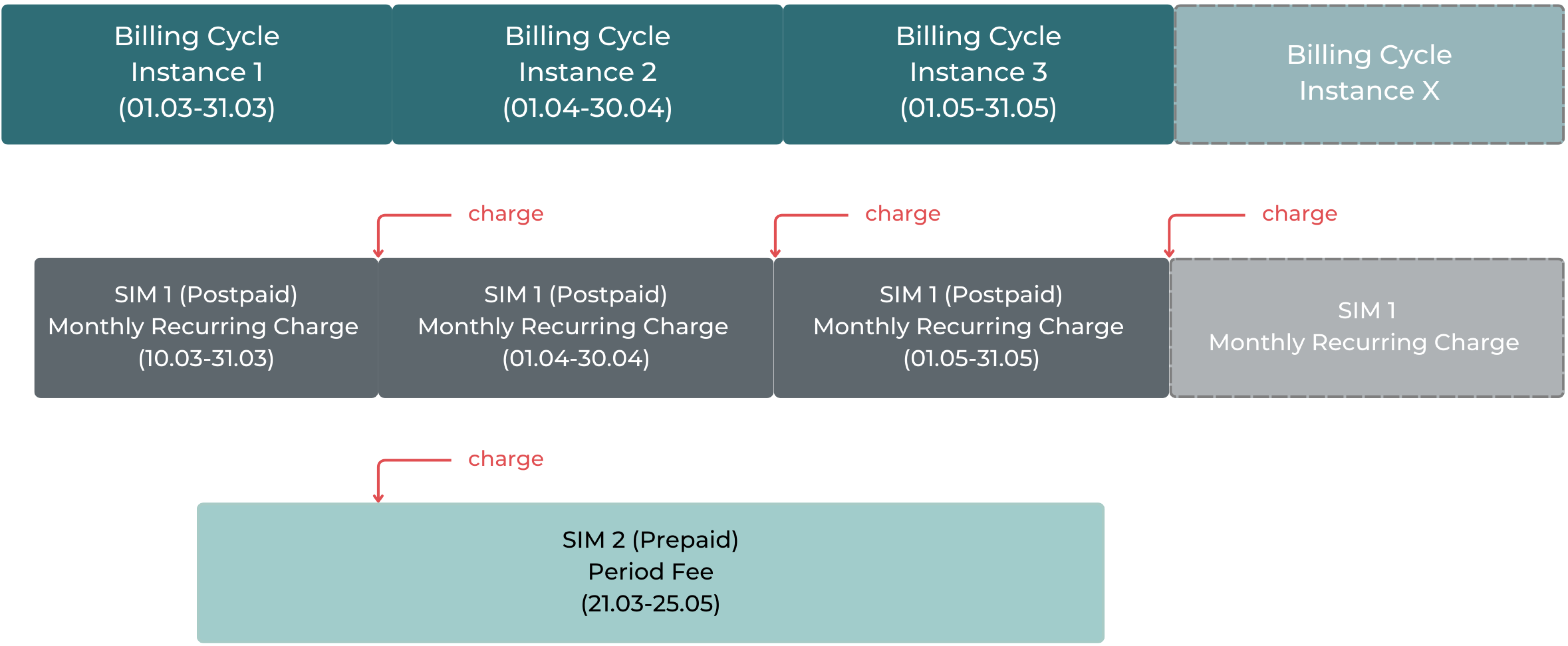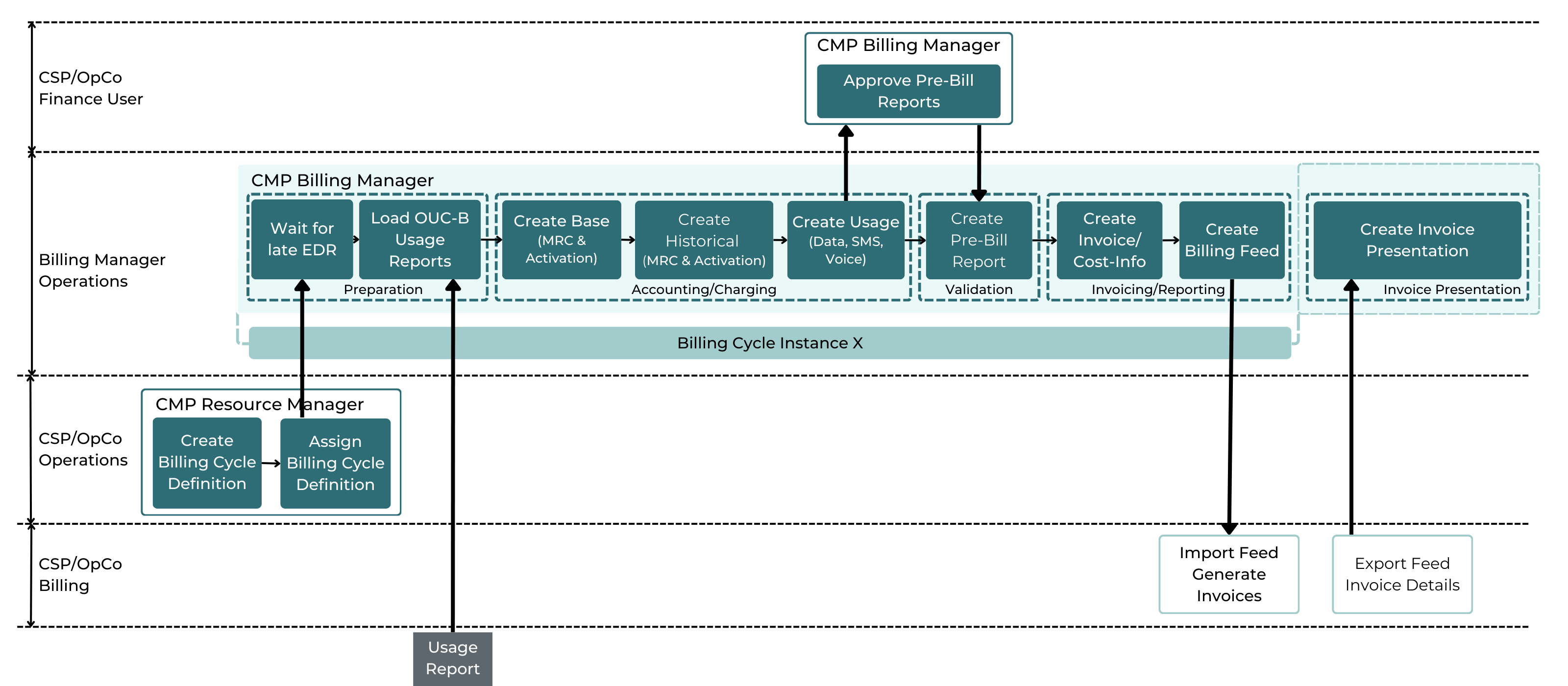Invoice Generation (FT-1015.003)
About this document
Scope
This document provides background information as well as a functional description of the FT-1015.003 Invoice Generation standard feature. The described feature is supported from the release version 3.0 onward.
Note
Invoice Generation is a standard feature and does not require a special license.
This feature is part of the Billing Cycle Management functionality with number FN-1015.
Feature Availability
Feature Version | Available from | Summary of changes |
|---|---|---|
v1 | CMP Release 3.0 | Initial release |
Benefits
MAVOCO CMP provides all the billing functionalities that a CSP might need, including generating the invoice for each Customer, so from functionality perspective, there is no need for an additional billing system. If the CSP chooses to use an additional Billing System for generating the Invoice documents, MAVOCO CMP will enable this by generating all the necessary cost information documents so that the CSP’s Billing System can always use the correct information. This flexibility allows the CSP to always generate correct invoices, regardless which system is chosen for this task.
Feature overview
Goals
The aim of the Invoice Generation feature is to support the execution of Billing Cycles and the generation of Invoices or Cost Info documents.
Functionality of the feature
In CMP, a Billing Cycle is always one month long and is recurring every month. A Billing Cycle Definition is assigned to each Account in CMP, to assign it to one of the available Billing Cycles.
CMP does support a total of 28 Billing Cycles, one for every day which exists in any month.

CMP executes one Billing Cycle Instance of each Billing Cycle Definition per month. Each cycle applies to all Accounts assigned to the related definition and automatically generates all types of costs (debit and credit) as configured in CMP.
Based on the Invoice Periodicity set for an account through its Accounting Group, invoices may not be generated every Billing Cycle. The available options for Invoice Periodicity are listed in the table below.
Monthly | Issue any costs every month by its respective Billing Cycle. |
|---|---|
Quarterly | Issue all costs just every quarter at January, April, July, and October Billing Cycles. |
Half-Yearly | Issue all costs just every half year at January and July Billing Cycles. |
Yearly | Issue all costs just once a year at the January Billing Cycle. |
The diagram below displays the basic schema of a Billing Cycle Instance, as well as the key phases during the process.

Billing Cycle Instance - Phases
Step | Description |
|---|---|
Wait for Late EDR | Billing Cycle does not start immediately after midnight, but waits for late EDRs (Usage Data Records) that still apply to the previous month (i.e., the event timestamp is from the previous month). This is configurable. Typically, the Billing Cycle begins at about 4 a.m. |
Load OUC-B Usage Report | Once the Billing Cycle has started, the first step is to load all Usage Reports from the OUC-B (Real-Time Rating Engine) and store (materialize) them in a relational database. The Usage Report contains aggregated Usage and Overage details per SIM (Individual Price Plan) and Pool (Pool Price Plan) - structured per Zone, APN, Rating Group, Time Slice, and Tier. All overage costs have already been calculated and are ready to be used at this time. |
Create Base | The second step includes MRC (Monthly Recurring Charge) and One-Time (Event) charges (like Activation Costs, Prepaid Period Fees, etc.). Those are based on the Subscriptions in CMP and do not take any changes (such as Price Plan changes) into account at this time. |
Create Historical | The next step includes the change history. This mainly applies to Pro-Rated Accounts, where CMP investigates all Subscription changes from the previous month, calculating different and adding additional charge items to reflect the full scope of Price Plan changes across the previous month. |
Create Usage | The next step takes all items from the "Load OUC-B Usage Report" phase and aggregates them for total Usage Costs per Usage Type (Data, SMS MO, ...) and generates an accurate representation of the Usage per Zone, APN, Rating Group, Time Slice, and Tier into an Accounting Item (to be used for Invoice or Cost Info generation later on). This step also aggregates the total Usage and Overage per Zone and stores it in a statistical data structure, which can be used later on by the Billing Feed. |
Create Pre-Bill Report | The Pre-Bill Report is generated once all Charge Items have been created. Basically, it simply aggregates all Accounting Items from previous steps and presents them in an Excel file format. The aim is to quickly identify gaps in total, Charge Type specific, or individual cost items. Manual Charge Corrections can still be added to the Billing Cycle at this stage. For more details on the Pre-Bill Report, please see the following feature description: Billing Cycle Pre-Run (FT-1015.002) |
Create Invoice/Cost-Info | Once the Pre-Bill Report has been approved, the final Invoices or Cost-Info Sheets are created as a PDF file, and get stored within CMP. Optionally, if configured and integrated, these documents can be submitted directly by CMP to the Account via email. Note: Before creating any documents, the system evaluates the total net summary. If a NetCost Threshold is configured for the related Account, the system compares the total net summary of the Account to this threshold.
|
Create Billing Feed | The Billing Feed is generated once the Billing Cycle has completed successfully. This step is fully optional and is based on configuration and integration. While CMP offers a "Standard Billing Feed" as an OOB feature (which contains all created Accounting Items along with dedicated Charge Codes), it usually gets customized as part of the integration, to fit all requirements of the external billing system (like file output format, charge line logic and delivery taxonomy). For more details on the Billing Feed, please see the following feature description: Billing Feed (FT-1007.005) |
Import Invoice Details | Following the successful completion of the Billing Cycle, the Invoice Details of the external billing system can be imported into CMP. This step is fully optional and is based on configuration and integration. While CMP offers an OOB "Standard Invoice Presentation" (based on charge items created by CMP during the Billing Cycle), it can also be customized to load external data. In the latter scenario, an integration has to apply to define the expected import format, file logic and delivery taxonomy. |
The Billing Cycle (except the Billing Feed) is executed within the Billing Manager.
It is controlled and monitored via the GUI. A User can view the status of any significant steps and access the Error File and Pre-Bill Report from there. Furthermore, a User can control the cycle to some extent by approving or resetting the Pre-Bill Report and accepting possible errors.

Billing Cycle Instance - Lifecycle
